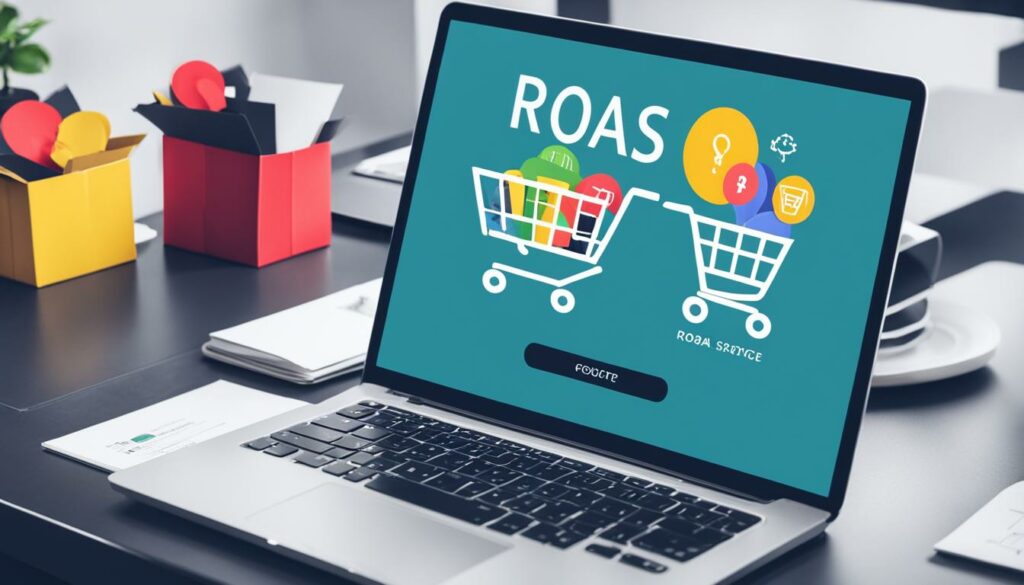Return On Advertising Spend (ROAS) is a marketing metric that measures the efficacy of digital advertising campaigns in the ecommerce industry. It helps online businesses evaluate the success of their advertising methods and identify opportunities for improvement. ROAS is calculated by dividing the gross revenue generated from an ad campaign by the cost of the campaign. It provides valuable insights that inform future budgets, strategies, and overall marketing direction. ROAS is an essential metric for ecommerce companies to make informed decisions about their ad investments and improve efficiency. It is important to consider all costs associated with advertising, such as partner/vendor fees, in-house advertising personnel expenses, and affiliate commissions, when calculating ROAS in order to have an accurate understanding of the campaign’s true effectiveness.
Key Takeaways:
- ROAS is a metric that measures the effectiveness of digital advertising campaigns in the ecommerce industry.
- It is calculated by dividing the gross revenue generated from an ad campaign by the cost of the campaign.
- ROAS provides valuable insights for future budgets, strategies, and marketing direction.
- Ecommerce companies should consider all costs associated with advertising when calculating ROAS.
- ROAS helps businesses make informed decisions and improve the efficiency of their ad investments.
Calculating ROAS in Ecommerce
Calculating return on advertising spend (ROAS) in ecommerce is crucial for measuring the effectiveness of ad campaigns. By determining how much revenue is generated for every dollar spent on advertising, ecommerce businesses can make informed decisions about their marketing strategies and optimize their ROI. To calculate ROAS, you can use the following formula:
ROAS = Gross Revenue / Advertising Cost
Let’s break down the formula:
- Gross Revenue: This refers to the total revenue generated from an ad campaign. It includes all sales directly attributed to the campaign.
- Advertising Cost: This includes all expenses associated with the ad campaign, such as ad spend, creative production, and any other relevant costs.
By dividing the gross revenue by the advertising cost, you can determine the ROAS ratio. This ratio indicates how much revenue is generated for every dollar spent on advertising. A ratio higher than 1 signifies a positive ROAS, indicating that the campaign generates more revenue than the cost of advertising.
For a better understanding, let’s take a look at an example:
| Advertising Cost | Gross Revenue | ROAS |
|---|---|---|
| $1,000 | $5,000 | 5 |
In this example, the advertising cost is $1,000, and the gross revenue generated from the campaign is $5,000. By dividing the gross revenue by the advertising cost, we get an ROAS of 5. This means that for every dollar spent on advertising, the campaign generates $5 in revenue.
Calculating ROAS in ecommerce provides valuable insights into the efficiency of advertising campaigns. It helps businesses identify successful campaigns, optimize ad spend, and maximize their return on investment. By tracking and analyzing ROAS, ecommerce companies can make data-driven decisions and allocate their advertising budget effectively to drive growth and profitability.
Importance of ROAS in Ecommerce
ROAS (Return On Advertising Spend) plays a vital role in the success of advertising campaigns in the ecommerce industry. By quantitatively evaluating the performance of these campaigns, online businesses gain valuable insights into their effectiveness and the impact they have on the bottom line. ROAS allows ecommerce companies to make informed decisions regarding the allocation of their advertising budget, enabling them to identify areas of improvement and maximize their returns.
One of the most common benchmarks for a good ROAS ratio in ecommerce is 4:1, meaning generating $4 in revenue for every $1 spent on advertising. However, it is important to note that acceptable ROAS ratios can vary depending on factors such as profit margins, operating expenses, and the overall health of the business.
For cash-strapped start-ups or businesses with lower profit margins, a higher ROAS ratio might be necessary to ensure profitability and sustainability. On the other hand, growing online stores with higher profit margins may be able to afford higher advertising costs, resulting in a comparatively lower ROAS ratio.
When determining the desired ROAS ratio for an ecommerce store, it is essential to consider industry standards, business size, and profit margins. Setting achievable and realistic goals for ROAS is crucial for guiding strategic decision-making and optimizing ad spend.
To provide further insights and guidance, let’s take a closer look at the following table that showcases industry-specific ROAS benchmarks for ecommerce:
| Industry | Recommended ROAS Benchmark |
|---|---|
| Apparel and Fashion | 5:1 |
| Electronics | 6:1 |
| Home and Garden | 4:1 |
| Health and Beauty | 3:1 |
| Food and Beverage | 7:1 |

Key Takeaways:
- ROAS is critical for evaluating the performance of advertising campaigns in ecommerce and making informed decisions about budget allocation.
- A benchmark of 4:1 is often considered favorable, but the acceptable ROAS ratio depends on factors such as profit margins and business health.
- Industry-specific benchmarks provide additional guidance for establishing ROAS goals.
Strategies to Improve ROAS in Ecommerce
In order to maximize ROAS in ecommerce, it is essential to implement effective strategies that can improve the performance of advertising campaigns. Here are some best practices that can help ecommerce businesses optimize their ROAS:
- Targeted Audience Segmentation: By segmenting your audience based on demographics, interests, and behaviors, you can create personalized and relevant ad campaigns that resonate with specific customer segments. This targeted approach can significantly improve the ROAS by increasing the chances of conversion.
- Optimized Ad Copy and Creative: Crafting compelling ad copy and creative that align with your target audience’s needs and desires is crucial for driving engagement and conversions. Use persuasive language, highlight the unique selling points of your products, and include a strong call-to-action to encourage viewers to take action.
- Continuous A/B Testing: Conducting A/B tests on different elements of your ad campaigns, such as headlines, images, calls-to-action, and landing pages, can provide valuable insights into what works best for your target audience. By analyzing the results and making data-driven decisions, you can refine your campaigns and improve ROAS over time.
- Remarketing and Retargeting: Implementing remarketing and retargeting strategies allow you to reach out to users who have previously interacted with your website or shown interest in your products. By delivering personalized ads to these audiences, you can increase the likelihood of conversions and boost ROAS.
- Mobile Optimization: With the increasing use of mobile devices for online shopping, it is important to optimize your ad campaigns and website for mobile users. Ensure that your ads are mobile-friendly, and provide a seamless mobile browsing and purchasing experience to maximize ROAS.
Case Study: Targeted Audience Segmentation
“By implementing targeted audience segmentation in our ad campaigns, we were able to significantly improve our ROAS in ecommerce. Instead of delivering generic ads to a wide audience, we segmented our customers based on their preferences and behaviors. This allowed us to create personalized campaigns that spoke directly to our target customers, resulting in higher engagement and conversions. Our ROAS increased by 30% within the first month of implementing this strategy.”
Strategies to Improve ROAS in Ecommerce
| Strategy | Description |
|---|---|
| Targeted Audience Segmentation | Segmenting your audience based on demographics, interests, and behaviors to create personalized ad campaigns. |
| Optimized Ad Copy and Creative | Creating compelling ad copy and creative that resonates with your target audience. |
| Continuous A/B Testing | Testing different elements of your ad campaigns to identify what works best for your target audience. |
| Remarketing and Retargeting | Targeting users who have previously interacted with your website or shown interest in your products. |
| Mobile Optimization | Optimizing your ad campaigns and website for a seamless mobile browsing experience. |
Implementing these strategies can help ecommerce businesses improve their ROAS and achieve better advertising results. By understanding your target audience, optimizing your ad content, conducting tests, and utilizing remarketing techniques, you can maximize your return on ad spend and drive greater success in your ecommerce endeavors.

Customer Behavior and Relation to Other Ecommerce Metrics
When it comes to determining the success of advertising campaigns in ecommerce, customer behavior is a key factor to consider. Understanding how customers interact with ads, navigate through the website, and take actions after clicking on an ad can provide valuable insights to optimize the Return on Advertising Spend (ROAS). By tracking metrics such as click-through rate (CTR), conversion rate, and average order value (AOV), ecommerce businesses can measure the impact of their advertising campaigns on both customer behavior and ROAS.
The click-through rate (CTR) indicates how many people click on an ad after viewing it. By analyzing CTR alongside ROAS, businesses can gain insights into the effectiveness of their ad creatives and messaging in capturing customer attention and driving engagement. A high CTR coupled with a strong ROAS suggests that the advertisement resonates well with the target audience and motivates them to take action.
The conversion rate measures the percentage of website visitors who complete a desired action, such as making a purchase or signing up for a newsletter. By evaluating the conversion rate in relation to ROAS, businesses can assess the quality of their traffic and the effectiveness of their landing pages. A high conversion rate combined with a positive ROAS indicates that the advertising campaign is not only attracting visitors but also converting them into customers.
Another crucial metric to consider is the average order value (AOV), which represents the average amount spent by customers when making a purchase. By analyzing AOV alongside ROAS, businesses can evaluate the effectiveness of their upselling and cross-selling strategies. A high AOV in conjunction with a strong ROAS implies that customers are not only making purchases but also spending more per transaction, maximizing the return on advertising investment.
FAQ
What is ROAS in Ecommerce?
ROAS (Return On Advertising Spend) is a marketing metric that measures the efficacy of digital advertising campaigns in the ecommerce industry. It helps online businesses evaluate the success of their advertising methods and identify opportunities for improvement.
How do I calculate ROAS in Ecommerce?
To calculate ROAS in ecommerce, divide the gross revenue generated from an ad campaign by the cost of the campaign. The formula for calculating ROAS is: ROAS = Gross Revenue / Advertising Cost.
Why is ROAS important in Ecommerce?
ROAS is important in ecommerce because it provides valuable insights that inform future budgets, strategies, and overall marketing direction. It helps ecommerce companies make informed decisions about their ad investments and improve efficiency.
What are some strategies to improve ROAS in Ecommerce?
Some strategies to improve ROAS in ecommerce include optimizing ad targeting, improving ad creatives, refining landing pages, utilizing retargeting campaigns, and leveraging data analysis to identify and optimize high-performing channels.
How does customer behavior relate to ROAS and other ecommerce metrics?
Customer behavior plays a crucial role in determining ROAS in ecommerce. Understanding how customers interact with ads, navigate through the website, and what actions they take after clicking on an ad provides valuable insights for optimizing ROAS. Tracking metrics such as click-through rate (CTR), conversion rate, and average order value (AOV) can help measure the impact of advertising campaigns on customer behavior and ROAS.
